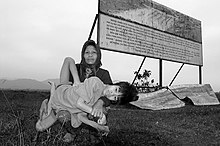Herbicidal warfare
This article needs additional citations for verification. (May 2010) |
| Part of a series on |
| Pollution |
|---|
 |
Herbicidal warfare is the use of substances primarily designed to destroy the plant-based ecosystem of an area. Although herbicidal warfare use
History
Modern day herbicidal warfare resulted from
Work on military herbicides began in
In May 1945,
Malaya
During the Malayan Emergency (1948–1960), the British military deployed herbicides and defoliants in the Malaysian countryside (including crop fields) in order to deprive Malayan National Liberation Army (MNLA) insurgents of cover, potential sources of food and to flush them out of the jungle. The herbicides and defoliants deployed by the British contained Trioxone, an ingredient which was also formed part of the chemical composition of the Agent Orange herbicide used by the U.S. military during the Vietnam War. Deployment of herbicides and defoliants served the dual purpose of thinning jungle trails to prevent ambushes and destroying crop fields in regions where the MNLA was active to deprive them of potential sources of food. In the summer of 1952, 500 hectares were sprayed with 90,000 liters of Trioxone from fire engines; the British found it difficult to operate the machinery in jungle conditions while wearing full protective gear. Herbicides and defoliants were also sprayed from Royal Air Force (RAF) aircraft.[3]
Historical records of DOW chemical show that "Super Agent Orange", also called DOW Herbicide M-3393, was Agent Orange that was mixed with picloram. Super Orange was known to have been tested by representatives from Fort Detrick and DOW chemical in Texas, Puerto Rico, and Hawaii and later in Malaysia in a cooperative project with the International Rubber Research Institute.[4]
Discussions in the British government centered on avoiding the thorny issue of whether herbicidal warfare in Malaya was in violation of the spirit of the 1925 Geneva Protocol, which only prohibited chemical warfare among signatory states in international armed conflicts. The British were keen to avoid accusations like the allegations of biological warfare in the Korean War leveled against the United States. The British government found that the simplest solution was to deny that a conflict was going on in Malaya. They declared the insurgency to be an internal security matter; thus, the use of herbicidal agents was a matter of police action, much like the use of CS gas for riot control.[3]
Many Commonwealth personnel who handled herbicides and defoliants during, and in the decades after, the conflict suffered from serious exposure to dioxin, which also led to soil erosion in areas of Malaysia. Roughly 10,000 civilians and insurgents in Malaysia also suffered from the effects of the defoliant, though many historians argue the true number was higher given that herbicides and defoliants were used on a large scale in the Malayan Emergency; the British government manipulated data and kept its deployment of herbicidal warfare secret in fear of a diplomatic backlash.[5][6][7]
Vietnam War

The
Ranch Hand started as a limited program of defoliation of border areas, security perimeters, and crop destruction. As the conflict continued, the anti-crop mission took on more prominence, and (along with other agents) defoliants became used to compel civilians to leave Viet Cong-controlled territories for government-controlled areas. It was also used experimentally for large area forest burning operations that failed to produce the desired results.

Defoliation was judged in 1963 as improving visibility in jungles by 30–75% horizontally, and 40–80% vertically. Improvements in delivery systems by 1968 increased this to 50–70% horizontally, and 60–90% vertically. Ranch Hand pilots were the first to make an accurate 1:125,000 scale map of the
Use of herbicides in Vietnam caused a shortage of commercial pesticides in mid-1966 when the Defense Department had to use powers under the Defense Production Act of 1950 to secure supplies.
The concentration of herbicides sprayed in Operation Ranch Hand was more than an order of magnitude greater than that in domestic use. Approximately 10% of the land surface of South Vietnam was sprayed—about 17,000 square kilometers. About 85% of the spraying was for defoliation and about 15% was for crop destruction.[8]
War on drugs in South America and Afghanistan
Types of herbicides
This section focuses only on one specialized aspect of the subject. (June 2013) |
This section needs additional citations for verification. (October 2016) |
The United States had technical military symbols for herbicides that have since been replaced by the more common color code names derived from the banding on shipping drums. The US further distinguished between tactical herbicides, which were to be used in combat operations and commercial herbicides, which used in and around military bases, etc.[9]
In 1966 the
Decades later the lingering problem of herbicidal warfare remains as a dominant issue of
See also
- E14 munition
- E77 balloon bomb
- Enterotoxin
- M115 bomb
- Mycotoxin
- United States Army Biological Warfare Laboratories
- War on drugs#Aerial herbicide application
References
- ^ "Convention on the Prohibition of Military or Any Other Hostile Use of Environmental Modification Techniques". UN. 10 December 1976.
- ISBN 978-0-8131-7052-7.
- ^ a b Bruce Cumings (1998). The Global Politics of Pesticides: Forging Consensus from Conflicting Interests. Earthscan. p. 61.
- ^ "Operational Evaluation of Super-Orange" via National Security Archives at George Washington University. retrieved 10-24-12
- ^ Pesticide Dilemma in the Third World: A Case Study of Malaysia. Phoenix Press. 1984. p. 23.
- ^ Arnold Schecter, Thomas A. Gasiewicz (4 July 2003). Dioxins and Health. pp. 145–160.
- ^ Albert J. Mauroni (July 2003). Chemical and Biological Warfare: A Reference Handbook. pp. 178–180.
- ISBN 978-0-674-04513-2.
- ISBN 978-0-387-87485-2
Further reading
- Martini, Edwin A. (2013). "Hearts, Minds, and Herbicides: The Politics of the Chemical War in Vietnam". Diplomatic History. 37 (1): 58–84. .
- Westing, A. H. (1989). "Herbicides in Warfare: The Case of Indochina" (PDF). In Bourdeau, P.; et al. (eds.). Ecotoxicology and Climate. Stanford University, Department of Global Ecology.
